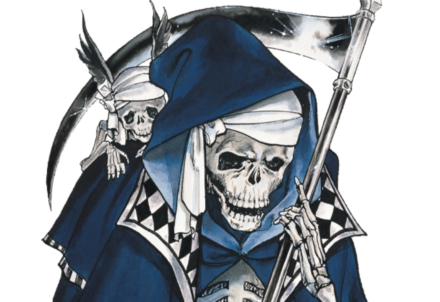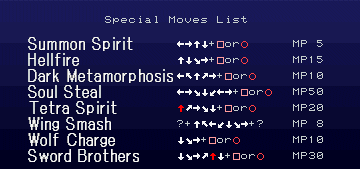The Complexities of Castlevania: SOTN – Tertiary Combat Systems
December 12th, 2017
[When developing Castlevania: Symphony of the Night, director Koji Igarashi wanted to make a game which would “overturn player’s ideas about Castlevania, yet also feel like a Castlevania game”. In pursuing this vision, his team made SOTN’s game system much more complex, incorporating RPG systems and a wide variety of nuanced player actions. This series of articles will examine how these additions shape SOTN’s core gameplay of moving through space to dodge and attack enemies.]
SOTN’s movement mechanics, standard weapons, and subweapons leverage the game’s core spatial and timing dynamics to offer the player various means of engaging with enemies (dancing up close with fists, aiming a projectile at a distance, etc.). However, the developers also made some weapons and mechanics too abstract, nuanced, or only particular to certain cases. As such, these parts of the game system fall way beyond the reach of the average player. SOTN’s tertiary systems generally fall into the same category, wasteful portions of the game design which contribute very little to SOTN’s core gameplay.
Expendable Weapons
The player can find various single use weapons throughout Dracula’s castle, such as javelins or TNT. These items function much like subweapons, but the pick-ups aren’t very common, leaving the player with few opportunities to experiment and figure out how best to work these attacks into their repertoire.
Furthermore, using an expendable weapon requires the player pause the game, unequip their current weapon, equip the expendable weapon, unpause, and then use the weapon. As players probably won’t have too many expendable weapons in hand, they’ll likely have to repeat the process soon after to re-equip their original weapon. So the interface acts as a further barrier to entry.
Spells
After buying the respective script from the castle’s librarian, Alucard can perform a spell by inputting a fighting game-esque sequence of inputs. (Alternatively, if you already know the button combinations, say, from an online FAQ, then you can learn the spells without paying for them). Although the text descriptions for spells are quite short, they provide enough information to get the player started. However, the spells aren’t particularly worthwhile, unless you’re looking to water down the combat difficulty. Dark Metamorphosis falls back on the blunt / sharp weapon attributes. Summon Spirit, Tetra Spirit, Soul Steal, and Sword Brothers attack nearby enemies (with Soul Steal healing Alucard as well). These insta-win spells aren’t terribly different from the Cross sub-weapon and allow the player to opt out of engaging enemies head-on. Wolf Charge and Wing Smash function similarly to Samus’s speed booster mechanic in the Metroid games, although without the destructible environment. Given the abundance of lengthy hallways and occasional large open area, these mechanics do allow for some fast travel. Hellfire’s teleportation doesn’t have much functional purpose (most enemies can be avoided with the traversal mechanics, which is a much more engaging than inputting a spell).
Familiars
Hagihara: But the familiars were something we barely had time to finish in the development, and they almost didn’t get added to the game. So most of the enemies aren’t really balanced with regard to the player using a familiar. What I’m trying to say is, please don’t overlevel the familiars. (laughs)
Igarashi: For people who think they’d be helpful for them, it’s fine to use them. But for those who don’t want the game balance broken, it’s also fine to ignore them.
Familiars are equipable buddy characters. They float around Alucard and perform certain actions depending on their individual personality. For example, the faerie heals Alucard when he’s low on health, while the sword will do various sweeping moves to attack nearby enemies. Other than choosing which familiar to equip, the player has no control over these assists. They attack on their own and level up on their own. In this sense, they generally make combat easier and introduce a weak variable factor into combat which can occasionally prompt the player to switch up tactics.
Equipment
Along with standard weapons, Alucard can equip headwear (for intelligence and defence), armour (for defence), cloaks (for constitution), and accessories (for added effects). As well as increasing Alucard’s stats, these items can grant specific properties. For example:
- Spike Breaker armour lets Alucard to walk through spikes.
- The Blood Cloak converts Alucard’s damage to hearts.
- The Shield Rod and a shield, when equipped in combination, allow Alucard to perform a special defence-boosting spell.
Unfortunately, the item description text in the equipment menu only offers a brief description of these nuanced properties, so knowing what items to equip and where to use them is a matter of trial and error. On the other hand, you could simply ignore the attributes and simply equip the item with the best stats.
Experience System
If you’ve read my writing before, you’ll probably know that I’m suspicious of levelling as this abstract force can deconstruct a game’s core gameplay. Although SOTN features character levelling, the experience system curbs grinding and encourages the player to fight statistically stronger enemies.
The game developers designate each enemy a level. Alucard’s experience for defeating an enemy is calculated by multiplying the enemy’s base EXP by 1.25 or dividing the enemy’s base EXP by 1.5, depending on Alucard’s relative level. So, if Alucard is one level below an enemy, he’ll gain the base EXP plus an additional 25%. The trick, though, is that if Alucard is two levels below an enemy, he’ll gain the result of the previous equation multiplied by 1.25—so (EXP X 1.25) X 1.25—and so on, up to five levels below. Conversely, when Alucard is a level higher an enemy, the enemy’s base experience is divided by 1.5. The division can shrink Alucard’s acquired experience down to a single digit,, thus making grinding on peon enemies a rather fruitless pursuit.
Although the levelling system cleverly minimises exploitation, aside from encouraging the player to tackle stronger enemies, it doesn’t do anything to make the combat more engaging.
Conclusion
SOTN’s tertiary systems generally contribute very little to the game’s combat. The levelling system increases Alucard’s stats and therefore controls a significant aspect of game difficulty. However, levelling by itself does not make combat any more varied, dynamic, or deeper. Familiars do influence combat through their behaviours; however, unless a player allows a familiar to significantly level up, their influence is negligible. According to the developers themselves, they didn’t have enough time to balance familiars, so if pursued, these tag-along creates can potentially have a negative effect on combat.
Expendable weapons, spells, and equipment increase the player’s viable options, but face a number of obstructions which limit regular players from adding them to their regular repertoire. Expendable weapons are closeted behind layers of inconvenient interface and are rare enough that players don’t really have many opportunities to put them to use. Equipment suffers from being too nuanced and the limited instruction provided by a brief text description in a menu. Spells have some utility, but mainly to water down combat.
Taken in sum, these systems suffer from a lack of functionality and clarity. Players can much more easily get through the game by focusing on the combat dynamics which they can see directly in front of them, as opposed to the abstract complexities hidden within these tertiary systems.





 Game Design Companion: A Critical Analysis of Wario Land 4 - $7.99
Game Design Companion: A Critical Analysis of Wario Land 4 - $7.99 Level Design: Processes and Experiences
Level Design: Processes and Experiences Speed Boost: The Hidden Secrets Behind Arcade Racing Design - $5.99
Speed Boost: The Hidden Secrets Behind Arcade Racing Design - $5.99 Adventures in Games Analysis: Volume I - $5.99
Adventures in Games Analysis: Volume I - $5.99







